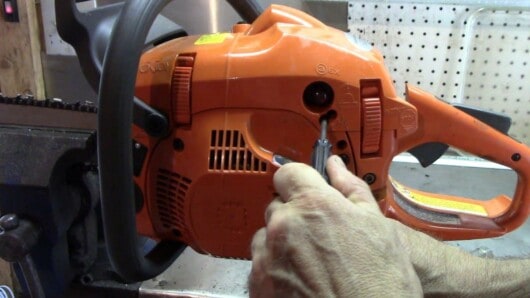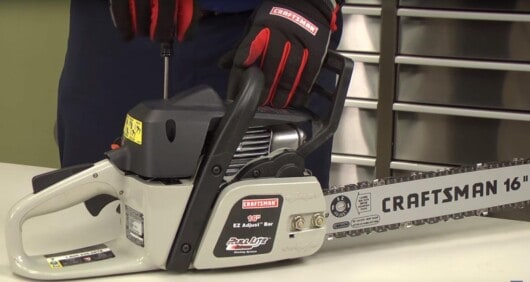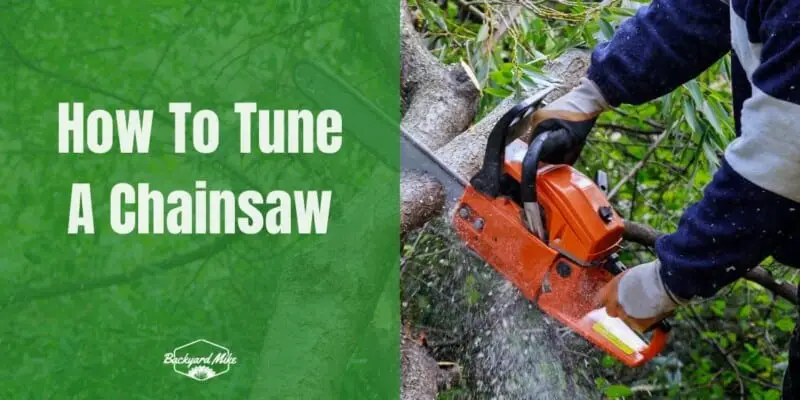Do you find your chainsaw being difficult to use because you don’t know how to tune a chainsaw? Don’t worry, it’s easy to tune a chainsaw if you know the proper steps. This is something you will get to know in this article.
Tuning a chainsaw means you have to adjust the carburetor. A carburetor can be easily tuned by adjusting the high, idle, and low-speed air-screws. Continue reading to know how to do that.
Why you should tune the carburetor?
It is important to tune your chainsaw carburetor; otherwise, your chainsaw could easily malfunction and be difficult to use. Tuning the carburetor the wrong way could potentially damage the engine eventually. It is important to be cautious when tuning the carburetor in the chainsaw.
When it comes to fuel-powered chainsaws, a carburetor will determine how much of the fuel is mixing with the air. This helps the chainsaw in functioning smoothly. If you mix too much fuel with the air, the engine eventually gets flooded with fuel. Meanwhile, adding too little fuel will leave the chainsaw with less power, and it could easily result in smoke. As a result, there can be some build-up, which in turn, damages the engine of the chainsaw.
How to tune a chainsaw and adjust the chainsaw carburetor
Step 1: Tune the high-speed airscrew
Remove the spark plug in the chainsaw and look for the screw located at the top of the spark plug cap. This is normally referred to as a “high-speed atmosphere screw” while some also call it an accelerator pump adjust. The rich speed airscrew will control the amount of air allowed to enter the fuel injector. You can easily find the screw on top of the engine, and it’ll be connected directly to the throttle trigger.
The high-speed atmosphere screw should be set to the correct adjustment position. It should be done when it starts to choke the engine when you’re revving up the throttle. You’ll require a flathead screwdriver to do that. You should ensure that it isn’t sharp enough to damage anything inside the engine case.
Step 2: Idle speed screw
Use a flathead screwdriver for turning the idle speed screw adjustment clockwise. Do this until it starts chocking off the engine at idle. This step will adjust how nicely your chainsaw is idling under different conditions.

Adjust the settings as they’ll help you get rid of popping and stalling occurring during changes in petrol type. The lean or idle speed adjustment screw is towards the side of the engine, making it fairly easy to access. Once you’ve set the high-speed adjustment screw and idle speed adjustment screw, your chainsaw will start up faster and smoother.
Step 3: Low-speed airscrew
Use a flathead screwdriver for turning the low-speed airscrew clockwise. Do this until it starts to choke off the engine when you’re revving up the throttle. This step will help you adjust how well the chainsaw runs at full power. The low-speed adjustment wind screw is located near the fuel injector area. However, it is difficult to spot with the sight of handlebars.
Once you’ve finished adjusting all three adjustment screws, you should test out how well your chainsaw runs. The last step will help your chainsaw run more swimmingly and powerfully. In case you have any problem with the chainsaw after carburetor tuning, go back to step 1. If it is difficult to access any of the adjustment screws, you should try cleaning them before you try again.
After following all the steps mentioned above, you’ll be able to make the adjustments. Tuning your carburetor will help your chainsaw run at its peak performance.
Important tips to keep in mind when tuning your chainsaw
- Make sure that the chainsaw is laying on a flat surface before you start tuning it.
- Make sure there are no unnecessary items lying around the chainsaw, especially around the chain area.
- You wouldn’t want anything to snag on the blades by mistake during the adjustment process.
- It is important to wear protective gear such as safety gloves when operating the chainsaw. Further, make sure you have safety goggles on alongside long pants and a full-sleeved jacket.
- Look at the air filter and clean it if required. If you forget to clean up the clogs, you’ll end up having to adjust the chainsaw with a dirty filter. Eventually, when the filter gets cleaned, the chainsaw will end up running clean.
- Remember to check the fuel level of the chainsaw. Ensure that the tank has more than 50% fuel capacity. If you’re adjusting the chainsaw with insufficient fuel, when the tank is filled eventually, the carburetor might be too adjusted.
- Start the engine and let it warm up a bit, as a cold engine may give you a rich adjustment.
- When you’re adjusting idle speed, remember to start by setting a speed of 2700 RPM using a tachometer. Ensure that the chainsaw doesn’t die idle, making the chainsaw run as soon as the throttle gets released.
- When adjusting low-speed, turn the screw inwards until the engine starves, and then note the position of the screw. Then, turn the screw outwards and make the engine run better.
- The ideal position of the screw is somewhere between the first and second noted positions. This is where the machine will be idle the best.
- When adjusting high-speed, turn the screw inwards until the mixture runs out. Then, turn the screw inward until hearing a flutter. You will get the correct RPM, which you will be able to check with a tachometer.
- Always consult the instruction manual or the chainsaw manufacturer’s website if you want added instructions.
Do new chainsaws come with tuned carburetors?
Sometimes, novice chainsaw users wonder why their chainsaws cannot come adjusted when they’re new and don’t need any tuning. It is important to understand that chainsaws cannot be set at the factory and be adjusted for the entire lifetime. The fact is, a few manufacturers have thought about this and tried to fix the jet and semi-fix jet carburetors. Such carburetors haven’t worked well. The reason is that elevation, fuel age, fuel type, humidity, and other factors need the carburetors to need periodic adjustment. It is helpful that you should adjust the carburetor for a wide variety of applications. For instance, chainsaws in mills should have high-speed adjustment set at rich due to high stress on the chainsaw.
What are the benefits of tuning the chainsaw carburetor?
- You will be able to save money on gas while improving engine performance at the same time.
- Chainsaw will start faster and run much more effectively.
- Your chainsaw will achieve its peak performance for cutting wood or branches.
- It is important for chainsaw maintenance. It is advised that you must do it after every 20 hours of usage or each time you drain the fuel tank.
- Chainsaw owners who have tuning issues with their saw’s engine performance should adjust the carburetor. This will result in comparatively better engine response as well as long-lasting usage.

Common mistakes beginners make when tuning the chainsaw carburetor
Incorrect fuel pressure
The most common mistake with carburetor tuning is not getting the right fuel pressure. It is recommended that you should maintain a regulated pressure of 5 to 5.5 PSI on the carburetor with a maximum of 6.5 PSI. Even using the wrong fuel quantity in the carburetor can be damaging.
Wrong carburetor size
Choosing the wrong carburetor size is a common beginner mistake and a recipe for disaster. If you have a small engine, having a smaller carburetor will be better. There is no truth to the myth that you can easily jet a bigger engine, and it’ll work the same.
Letting your friend tune your carburetor
Although your friend might be excited about your new purchase and want to help with the maintenance of the chainsaw. However, you shouldn’t let someone with no knowledge of chainsaw to touch your chainsaw, let alone tune the carburetor. Even a small mistake when tuning the carburetor could lead to a massive bill for you. If the carburetor is tuned wrongly, you will need to get the chainsaw fixed by a professional.
Not following the instructions
Sometimes, people think that they know more than they actually do, and they end up not consulting the instruction manual. You shouldn’t get ahead of yourself and always follow the right procedure and be careful when tuning the chainsaw carburetor. Sometimes, all it can take is one loss of judgment and your carburetor could be damaged.
Setting the idle wrong
The carburetor types are designed with the right number of idle mixture screws for keeping the fuel flow at idle. They are usually right on the money. When you’re tuning the chainsaw, you should keep in mind that you don’t make any drastic adjustments to the idle speed screws. Moreover, you shouldn’t set the idle wrong, as it doesn’t take a lot for something to go wrong with the carburetor.
Conclusion
There you have it, now you know how to tune a chainsaw or more specifically, how to tune the carburetor in the chainsaw. As your carburetor is an incredibly important component of your chainsaw, it is important to keep it functioning smoothly. It is important to tune it from time to time and ensure that your chainsaw is running appropriately. Not only will it improve the performance, but it’ll also increase the lifespan of your chainsaw.


